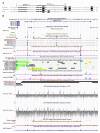Advances in tryptophan hydroxylase-2 gene expression regulation: new insights into serotonin-stress interaction and clinical implications
- PMID: 22241550
- PMCID: PMC3587664
- DOI: 10.1002/ajmg.b.32023
Advances in tryptophan hydroxylase-2 gene expression regulation: new insights into serotonin-stress interaction and clinical implications
Abstract
Serotonin (5-HT) modulates the stress response by interacting with the hormonal hypothalamic-pituitary-adrenal (HPA) axis and neuronal sympathetic nervous system (SNS). Tryptophan hydroxylase (TPH) is the rate-limiting enzyme in 5-HT biosynthesis, and the recent identification of a second, neuron-specific TPH isoform (TPH2) opened up a new area of research. While TPH2 genetic variance has been linked to numerous behavioral traits and disorders, findings on TPH2 gene expression have not only reinforced, but also provided new insights into, the long-recognized but not yet fully understood 5-HT-stress interaction. In this review, we summarize advances in TPH2 expression regulation and its relevance to the stress response and clinical implications. Particularly, based on findings on rhesus monkey TPH2 genetics and other relevant literature, we propose that: (i) upon activation of adrenal cortisol secretion, the cortisol surge induces TPH2 expression and de novo 5-HT synthesis; (ii) the induced 5-HT in turn inhibits cortisol secretion by modulating the adrenal sensitivity to ACTH via the suprachiasmatic nuclei (SCN)-SNS-adrenal system, such that it contributes to the feedback inhibition of cortisol production; (iii) basal TPH2 expression or 5-HT synthesis, as well as early-life experience, influence basal cortisol primarily via the hormonal HPA axis; and (iv) 5'- and 3'-regulatory polymorphisms of TPH2 may differentially influence the stress response, presumably due to their differential roles in gene expression regulation. Our increasing knowledge of TPH2 expression regulation not only helps us better understand the 5-HT-stress interaction and the pathophysiology of neuropsychiatric disorders, but also provides new strategies for the treatment of stress-associated diseases.
Copyright © 2012 Wiley Periodicals, Inc.
Figures

References
-
- Al-Janabi I, Arranz MJ, Blakemore AIF, Saiz PA, Susce MT, Glaser PEA, Clark D, de Leon J. Association study of serotonergic gene variants with antipsychotic-induced adverse reactions. Psychiatric Genetics. 2009;19(6):305–311. - PubMed
-
- Andrews MH, Matthews SG. Programming of the Hypothalamo–Pituitary–Adrenal Axis: Serotonergic Involvement. Stress. 2004;7(1):15–27. - PubMed
-
- Anttila S, Viikki M, Huuhka K, Huuhka M, Huhtala H, Rontu R, Lehtimχi T, Leinonen E. TPH2 polymorphisms may modify clinical picture in treatment-resistant depression. Neuroscience Letters. 2009;464(1):43–46. - PubMed
Publication types
MeSH terms
Substances
Grants and funding
LinkOut - more resources
Full Text Sources
Medical

